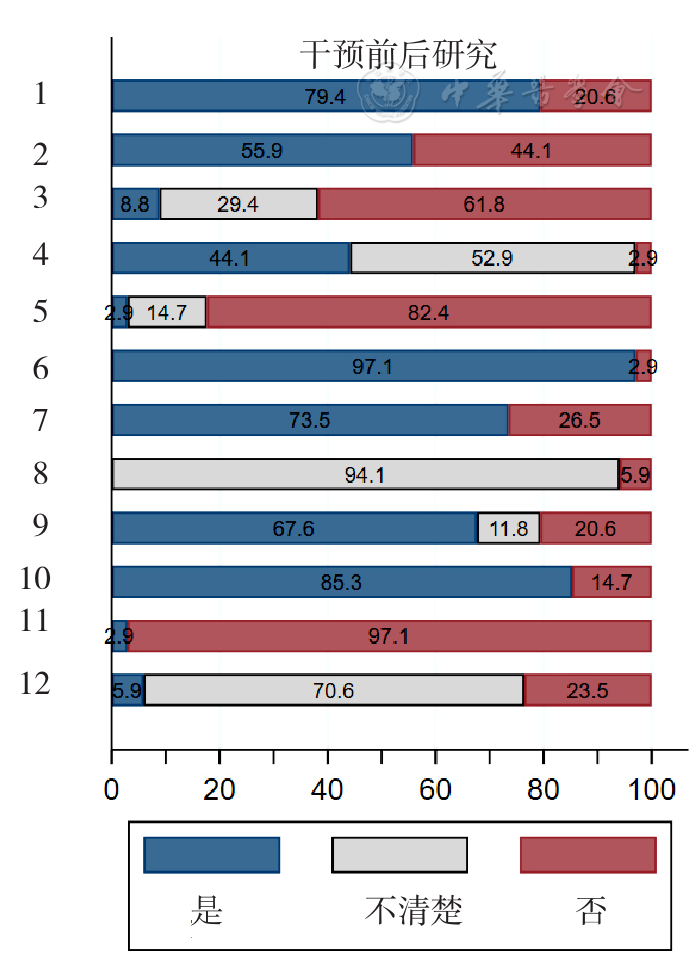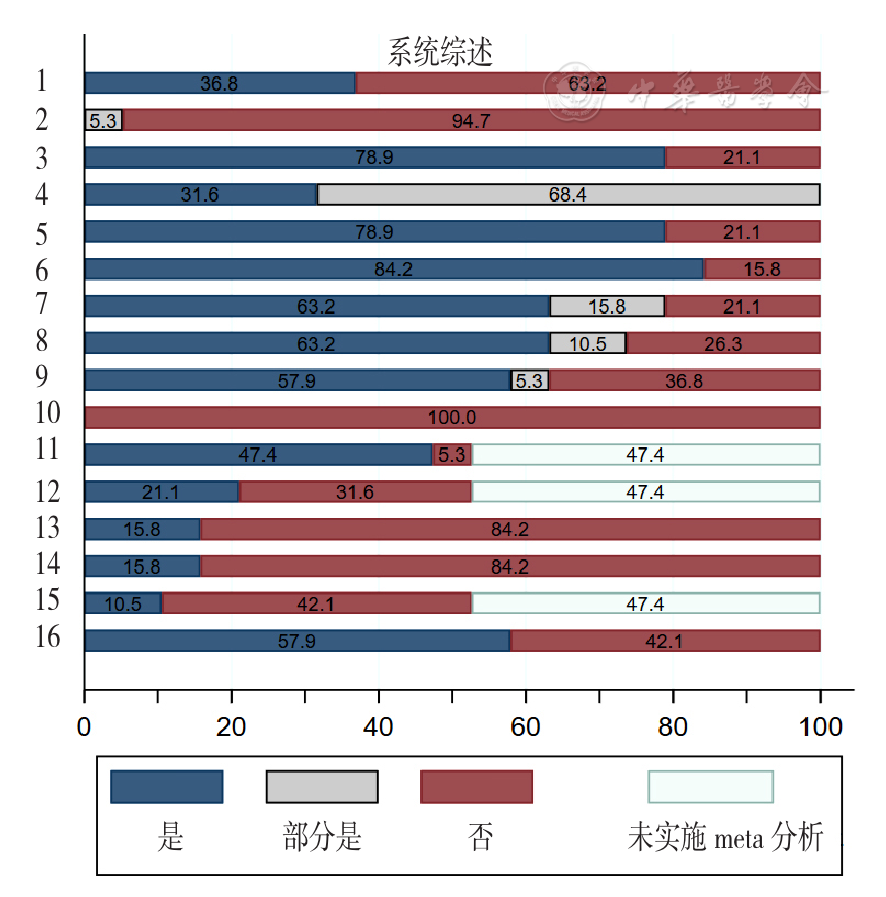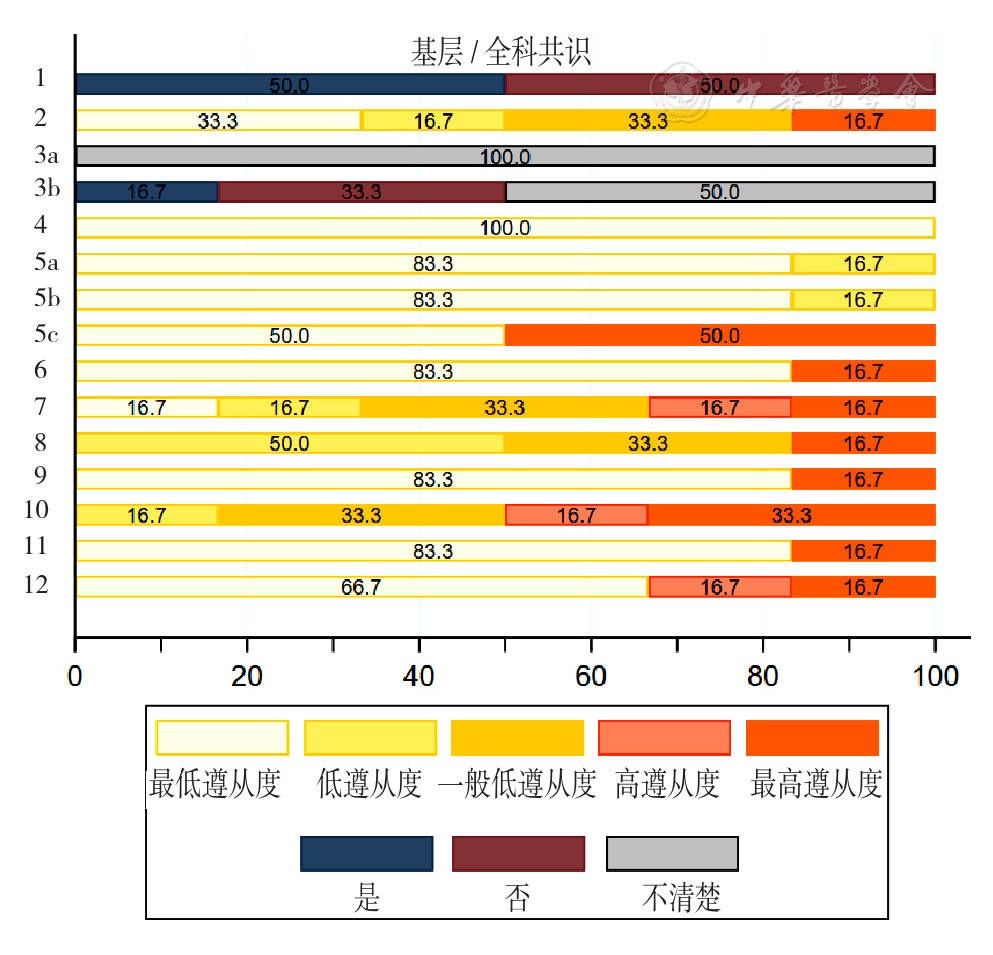中国全科医学 ›› 2024, Vol. 27 ›› Issue (07): 773-783.DOI: 10.12114/j.issn.1007-9572.2023.0751
《中国全科医学》定量研究、系统综述和指南/共识质量评价小组
收稿日期:2023-10-11
修回日期:2023-11-06
出版日期:2024-03-05
发布日期:2023-12-19
Quality Assessment Group for Quantitative Research,Systematic Review and Guidelines/Consensus of Chinese General Practice
Received:2023-10-11
Revised:2023-11-06
Published:2024-03-05
Online:2023-12-19
摘要: 背景 在新时期医疗卫生改革正在实施的当下,我国全科医学和基层卫生领域的科研产出近年来增长迅速,但文献的方法学质量尚不清楚。目的 对我国学者2021年发表的全科医学和基层卫生领域具有代表性的定量研究、系统综述和指南类文献进行方法学质量评价,以呈现该领域科研论文总体的方法学质量特征。方法 自《2021年中国基本保健和全科医学科研论文生产力研究》中收集的3 122篇论文中选取449篇论文,组织由22位来自不同机构的公共卫生和全科医学领域研究人员组成方法学质量评价小组,以2人1组的形式,在1位循证医学方法学专家的培训和指导下,使用6种适用于不同研究设计(横断面研究、队列研究、干预前后研究、随机对照试验、系统综述、临床指南/共识)的质量评价工具,对其中的320篇论文(71.3%)进行质量评价,并运用描述性统计方法,报告质量评价结果。结果 114篇横断面研究论文质量问题主要为研究人群是否代表目标人群(41.2%)、调查工具的可靠性和有效性是否可以确证(32.5%)、该调查是否具有临床意义(26.3%)3个条目;25篇队列研究论文质量问题在是否对队列进行了充分随访(44.0%)和各组之间的共同干预是否相似(56.0%)两个条目较为集中;34篇干预前后研究质量问题主要存在于是否在干预前后多次测量目标结局(97.1%),样本量是否足够大、足以对研究结果产生信心(82.4%)以及研究参与者能否代表符合条件的人群(61.8%)3个条目;122篇随机对照试验质量问题多集中于对不同的利益相关者实施盲法(25.4%~61.5%),对随机分配的充分隐藏(41.8%)及其他偏倚风险(72.1%)3个条目;19篇系统综述质量问题主要存在于是否报告了纳入研究的资助来源(100.0%)、综述方法是否在综述开始前制定(94.7%)、是否合理的讨论和解释了异质性(84.2%)和是否考虑了个别研究的偏倚风险(84.2%)4个条目;6篇临床指南/共识的质量均评价较低。结论 我国基本保健和全科医学领域近年的科研成果在总体上方法学质量仍有限,在横断面研究、干预前后研究、随机对照试验、临床指南/共识等类别的研究中表现得尤为严重。这凸显了在我国这一研究领域加强系统性的基础科研培训、增强对科研和循证报告规范的重视,以及开发务实的制订指南的方法学规范的迫切性和重要性。
| 论文来源 | 横断面调查 | 干预性研究(非RCTs) | 随机对照试验(RCTs) |
|---|---|---|---|
| 中文核心期刊 | 33 | 8 | 8 |
| SCI/SSCI期刊 | 12 | 1 | 3 |
| 其他非核心期刊 | 75 | 100 | 114 |
表1 本研究抽样的3种论文的数量(篇)
Table 1 The number of three types of articles sampled in this study
| 论文来源 | 横断面调查 | 干预性研究(非RCTs) | 随机对照试验(RCTs) |
|---|---|---|---|
| 中文核心期刊 | 33 | 8 | 8 |
| SCI/SSCI期刊 | 12 | 1 | 3 |
| 其他非核心期刊 | 75 | 100 | 114 |
| 研究方法 | 评价论文数量(抽选论文数量) | 评价专家人数 | 评价时间 | 评价工具 | 开发者 |
|---|---|---|---|---|---|
| 横断面研究 | 114(120)篇 | 6位 | 3周 | Risk of Bias Instrument for Cross-Sectional Surveys of Attitudes and Practices [ | CLARITY Group at McMaster University |
| 队列研究 | 25(68)篇 | 2位 | 2周 | Tool to Assess Risk of Bias in Cohort Studies McMaster University[ | CLARITY Group at McMaster University |
| 干预前后研究 | 34(109)篇 | 2位 | 1周 | Quality Assessment Tool for Before-After (Pre-Post) Studies With No Control Group[ | National Heart,Lung,and Blood Institute |
| 随机对照试验 | 122(125)篇 | 10位 | 9周 | Tool to Assess Risk of Bias in Randomized Controlled Trials[ | CLARITY Group at McMaster University |
| 临床指南(共识) | 6(7)篇 | 2位 | 3周 | National Guideline Clearinghouse Extent of Adherence to Trustworthy Standards Instrument[ | Institute of Medicine |
| 系统综述 | 19(20)篇 | 2位 | 3周 | AMSTAR 2 (A MeaSurement Tool to Assess systematic Reviews 2)[ | AMSTAR 2 Research Group |
表2 不同类别方法文献的论文数量、专家数量和评价工具
Table 2 Number of papers,number of experts and assessment tools for different categories of methodological research literature
| 研究方法 | 评价论文数量(抽选论文数量) | 评价专家人数 | 评价时间 | 评价工具 | 开发者 |
|---|---|---|---|---|---|
| 横断面研究 | 114(120)篇 | 6位 | 3周 | Risk of Bias Instrument for Cross-Sectional Surveys of Attitudes and Practices [ | CLARITY Group at McMaster University |
| 队列研究 | 25(68)篇 | 2位 | 2周 | Tool to Assess Risk of Bias in Cohort Studies McMaster University[ | CLARITY Group at McMaster University |
| 干预前后研究 | 34(109)篇 | 2位 | 1周 | Quality Assessment Tool for Before-After (Pre-Post) Studies With No Control Group[ | National Heart,Lung,and Blood Institute |
| 随机对照试验 | 122(125)篇 | 10位 | 9周 | Tool to Assess Risk of Bias in Randomized Controlled Trials[ | CLARITY Group at McMaster University |
| 临床指南(共识) | 6(7)篇 | 2位 | 3周 | National Guideline Clearinghouse Extent of Adherence to Trustworthy Standards Instrument[ | Institute of Medicine |
| 系统综述 | 19(20)篇 | 2位 | 3周 | AMSTAR 2 (A MeaSurement Tool to Assess systematic Reviews 2)[ | AMSTAR 2 Research Group |

图3 干预前后研究质量评价结果注:1为研究问题或目标是否明确阐述?2为研究人群的选择标准是否预先设定并清楚描述?3为研究中的参与者是否能代表在一般或临床人群中符合条件的人群?4为所有符合预设入选标准的潜在参与者是否能被纳入研究?5为样本量是否足够大,以便对研究结果产生信心?6为测试/服务/干预是否清楚地描述并在研究人群一致地实施?7为结局测量是否预设,定义清晰有效可靠,并在所有参与者中一致评估?8为评估结果的人员是否对参与者的暴露/干预情况进行了盲法处理?9为基线后的失访率是否在20%或以下?分析中是否考虑了失访的人员?10为统计方法是否检查了干预前后结局测量的变化?并进行了相关统计检验?11为干预前后的结果测量是否多次进行?12为如果是集群干预,统计分析是否使用个体层级数据来确定集群效果?
Figure 3 Quality evaluation results of the pre- and post-intervention studies

图5 系统综述质量评价结果注:1为研究问题和纳入标准是否包括PICO?2为综述方法是否在综述开始前制定?3为是否解释了纳入综述的研究设计选择?4为是否使用了全面的文献检索策略?5为是否重复进行了研究筛选?6为是否重复进行了数据提取?7为是否提供了排除研究的清单并证明排除的合理性?8为是否充分详细地描述了纳入的研究?9为是否评估了单一研究的偏倚风险?10为是否报告了纳入综述的研究的资金来源?11为是否使用了适当的方法对结局进行统计组合?12为是否评估了单一研究的偏倚风险对meta分析的影响?13为讨论结果时是否考虑了个别研究的偏倚风险?14为是否对异质性提供了令人满意的解释和讨论?15为是否对发表偏倚进行了充分的调查?16为是否报告了任何潜在的利益冲突?
Figure 5 Quality evaluation results of the systematic reviews

图6 基层卫生/全科医学共识质量评价结果注:1为披露了指南/共识的资金来源;2为披露和管理成员的财务利益相关;3a为指南/共识开发小组由多科学专家组成;3b为指南/共识制定小组包含方法学专家;4为考虑患者和公众视角;5a为基于对证据的系统综述:报告检索策略;5b为基于对证据的系统综述:报告研究选择;5c为基于对证据的系统综述:报告证据合成;6为对证据强度或质量进行评级;7为报告和推荐相关的损益;8为报告支持推荐的证据概述;9为对推荐的强度进行评级;10为对推荐的表述具体且明确;11为进行外部审核;12为更新。
Figure 6 Quality evaluation results of the consensus
| [1] |
World Health Organization. Operational framework for primary health care:transforming vision into action[Z]. [2023-02-11].
|
| [2] |
国家市场监督管理总局. 中华人民共和国基本医疗卫生与健康促进法[EB/OL]. (2019-12-28)[2023-04-10].
|
| [3] |
曹新阳,汪洋,徐志杰,等. 2021年中国基本保健和全科医学科研论文生产力研究[J]. 中国全科医学,2022,25(34):4232-4240,4258. DOI:10.12114/j.issn.1007-9572.2022.0701.
|
| [4] | |
| [5] |
付强强,金花,于德华. 2001—2020年中国全科医学与社区卫生研究能力发展状况与策略[J]. 中国全科医学,2022,25(34):4252-4258. DOI:10.12114/j.issn.1007-9572.2022.0705.
|
| [6] |
|
| [7] |
|
| [8] |
Risk of Bias Instrument for Cross-Sectional Surveys of Attitudes and Practices[EB/OL].[2023-10-01].
|
| [9] |
Tool to assess risk of bias in cohort studies[EB/OL].[2023-10-01].
|
| [10] |
|
| [11] |
Study quality assessment tools-Quality assessment of controlled intervention studies[EB/OL].[2023-10-01].
|
| [12] |
|
| [13] |
|
| [14] |
|
| [15] |
|
| [16] |
|
| [17] |
|
| [18] |
|
| [19] |
|
| [20] |
施利波,朱田柱,沈美,等. 上海市崇明区家庭医生团队对社区药学照护的认知和障碍分析[J]. 药学实践杂志,2021,39(6):577-580. DOI:10.12206/j.issn.1006-0111.202104086.
|
| [21] |
詹思延. 临床流行病学[M]. 2版. 北京:人民卫生出版社,2015.
|
| [22] |
沈洪兵,齐秀英. 流行病学[M]. 8版. 北京:人民卫生出版社,2013.
|
| [23] |
颜虹,徐勇勇. 医学统计学[M]. 3版. 北京:人民卫生出版社,2015.
|
| [24] |
|
| [25] |
UK Government. Before and after study:comparative studies[EB/OL].[2023-02-15].
|
| [26] |
|
| [27] |
|
| [28] |
|
| [29] |
邹川,欧健铭,曾欣,等. 开展全科教育干预研究:从设计到发表[J]. 中国全科医学. DOI:10.12114/j.issn.1007-9572.2022.0597.
|
| [30] |
|
| [31] |
|
| [32] |
|
| [33] |
|
| [34] |
Queen's university library-systematic reviews&other syntheses[EB/OL].[2023-10-01].
|
| [35] |
JBI manual for evidence synthesis[EB/OL].[2023-10-01].
|
| [36] |
Centre for Reviews and Dissemination. Health & Environmental Research Online[M]. York:Centre for Reviews and Dissemination,University of York,2013.
|
| [37] |
|
| [38] |
|
| [39] |
|
| [40] |
|
| [41] |
Institute of Medicine Committee on Standards for Developing Trustworthy Clinical Practice Guidelines. Clinical practice guidelines we can trust[M]. Washington(DC):National Academies Press,2011.
|
| [42] |
|
| [43] |
U.S. Preventive Services Task Force. USPSTF Home[EB/OL].[2023-10-01].
|
| [44] |
The Royal Australian College of General Practitioners. Guidelines for preventive activities in general practice[M]. East Melbourne:Vic,2018.
|
| [45] |
|
| [46] |
JAMA evidence-decision making and the patient[EB/OL].[2023-10-01].
|
| [47] |
|
| [48] |
Guidelines Review Committee,Quality Assurance of Norms and Standards. WHO handbook for guideline development,2nd Edition[Z]. 2014.
|
| [49] |
GIN-McMaster Guideline Development Checklist[EB/OL].[2023-10-01].
|
| [50] |
|
| [51] |
|
| [52] |
杨楠,赵巍,潘旸,等. 针对临床实践指南科学性、透明性和适用性的评级工具研发[J]. 中华医学杂志,2022,102(30):2329-2337. DOI:10.3760/cma.j.cn112137-20220219-00340.
|
| [1] | 杨辉. 医学中的全科医学——从《柳叶刀》200年历史看现代医学中的全科医学发展(八): 对恩格尔生物心理社会范式的思辨[J]. 中国全科医学, 2024, 27(12): 0-D. |
| [2] | 史威力, 李明艳, 段红艳. 《他汀类药物用于成年人心血管疾病的一级预防:美国预防临床服务指南工作组推荐声明》解读[J]. 中国全科医学, 2024, 27(12): 1405-1412. |
| [3] | 曾凌枫, 张慧, 雷思, 卓慧, 叶云, 许琰, 罗荧荃. 《成年人阻塞性睡眠呼吸暂停低通气综合征筛查:美国预防临床服务指南工作组推荐声明》解读[J]. 中国全科医学, 2024, 27(12): 1412-1416. |
| [4] | 康静, 张赐, 张正义. 三级医院全科医学科中年住院患者慢性病共病分布及影响因素研究[J]. 中国全科医学, 2024, 27(11): 1310-1315. |
| [5] | 李明艳, 史威力, 段红艳. 阿司匹林用于成年人心血管疾病的一级预防:美国预防临床服务指南工作组推荐声明解读[J]. 中国全科医学, 2024, 27(11): 1277-1282. |
| [6] | 李迎晨, 赵明芳, 吴瑛. 《肺癌筛查:美国预防临床服务指南工作组推荐声明》现状与最新指南解读[J]. 中国全科医学, 2024, 27(11): 1283-1287. |
| [7] | 杨辉. 医学中的全科医学——从《柳叶刀》200年历史看现代医学中的全科医学发展(七): 马勒博士的健康建制[J]. 中国全科医学, 2024, 27(11): 0-F. |
| [8] | 《中国全科医学》定性和混合方法研究质量评价小组. 2021年中国基层卫生和全科医学研究方法学质量评价报告:定性研究和混合方法研究部分[J]. 中国全科医学, 2024, 27(10): 1173-1178. |
| [9] | 钟锦佳, 李文涛, 黄亚芳, 吴浩. 初级保健领域基于机器学习预测模型研究的设计特征与方法学质量:范围综述[J]. 中国全科医学, 2024, 27(10): 1271-1276. |
| [10] | 杨辉. 浅谈姑息照顾与临终关怀[J]. 中国全科医学, 2024, 27(09): 0-C2. |
| [11] | 杨辉. 医学中的全科医学[J]. 中国全科医学, 2024, 27(08): 0-C2. |
| [12] | 赵稳稳, 王荣英, 张金佳, 张雅丽, 张敏. 全科医学师资质量评价体系建设研究进展[J]. 中国全科医学, 2024, 27(07): 784-788. |
| [13] | 齐殿君, 江南, 于晓松. 我国本科生全科医学教育教学情况调查研究[J]. 中国全科医学, 2024, 27(07): 789-793. |
| [14] | 张锦欣, 姚能亮, 孙晓杰. 失能老人照护与支持需求质性研究的系统评价[J]. 中国全科医学, 2024, 27(07): 867-876. |
| [15] | 杨辉. 医学中的全科医学——从《柳叶刀》200年历史看现代医学中的全科医学发展(五):约翰·弗莱的国家间全科比较研究[J]. 中国全科医学, 2024, 27(06): 0-H. |
| 阅读次数 | ||||||
|
全文 |
|
|||||
|
摘要 |
|
|||||





